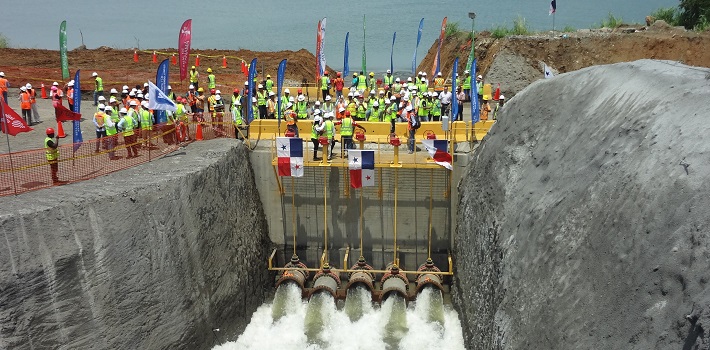Thabata Molina reports in the PanAm Post about the filling of the new locks of the expanded Panama Canal.
“Take note buddy: June 11, 2015. This is a historic day,” said one of the hundreds of construction workers and Panama Canal Authority (ACP) executives witnessing the five valves open and begin to funnel tonnes of water from Lake Gatún into the new, empty locks.
The Canal’s operators will need to test and calibrate the locks before the new Panama Canal extension can welcome ships sailing from Lake Gatún toward the Atlantic Ocean. The expansion project began seven years ago, and Panamanian authorities at the event expected the new route to be commercially available by the end of April 2016.
Once the works are completed, Canal management hope to double capacity, and allow ships one and a half times the current width and length, and over double the previous possible cargo, to pass through the Pacific-Caribbean conduit. Monolithic New Panamax container ships are already under construction in several parts of the world, measuring up at 427m in length, 55m in beam, and 18.3m in depth.
“We’re very glad today because this is the beginning of the testing phase. It’s the final phase that begins with the opening of the five valves to flood the cavity and check how the locks function,” explained Giuseppe Quarta, CEO of Grupos Unidos por el Canal, the private contractor tasked with expanding the Panama Canal.
At 11:45 a.m. local time, the canal engineers opened the valves on the side of Lake Gatún, and minutes later water flowed through the thick pipes. As soon as the first streams poured into the lock, the public broke into applause and cheers.
“It’s an extremely important accomplishment for the Panama Canal expansion project. We’re officially opening the valves to run the tests that will allow us to serve the larger ships we cannot cater to today,” said Jorge Luis Quijano, ACP administrator.
“The filling up process is a long one that won’t finish today. It takes between four and five days for the water to reach the required level to make the locks float and roll. It’s been a long time but we’re entering the expansion project’s final straight, and we hope that it will be done by August,” he added.
From now on, gravity will carry the water from the lake to the canal.
“We’re satisfied because the work is 90 percent complete. Most of the concrete has been poured in, some 5 million cubic meters. Now comes the somewhat more technical, but equally important part, the electromechanical one. It consists of flooding the area with water to make the locks float, and wait for them to align inside the rails to be able to roll,” explained Roberto Roig, one of the project’s engineers.
Roig said the flooding of the third set of locks from the Pacific Ocean side will be carried out in late July. In this case, however, pumps will carry the water toward the locks.
“This is an important development for our country, which we’re proud to be a part of. We’re pleased that the company has respected the rights of employers and the project can be concluded with goodwill from both sides,” Esteban Sugaste, a representative from the national union of construction-related sectors, told press.
The Panama Canal Expansion in Numbers
At least 50,000 people have worked in the Panama Canal’s expansion works, both in the Atlantic and Pacific routes.
In total, the third set of locks is comprised of eight exit gates to the Atlantic Ocean and eight gates to the Pacific Ocean.
The initial flooding will allow engineers to run qualitative tests on opening and closing the gates once the water reaches 27 meters high.
The Panama Canal authorities reported that the huge new gates were manufactured in Italy, and transported to Central America in four delivery ships between August 20, 2013 and November 12, 2014
